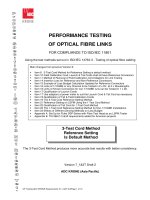PERFORMANCE TESTING OF COPPER PERMANENT LINKS AND CHANNEL
Bạn đang xem bản rút gọn của tài liệu. Xem và tải ngay bản đầy đủ của tài liệu tại đây (206.7 KB, 9 trang )
Field Performance Testing V10 050111 Page 1 of 9
PERFORMANCE TESTING
OF COPPER
PERMANENT LINKS AND CHANNEL
Changes from Version 9;
Fluke DTX-1200 set-up info added (Pg 5).
Tester set-up for DTX-1200/1800 added (Pg 9)
Issued Version 10 110105
This document is available as a free download from the KRONE web site
www.krone.com.au/tech/whitepapers/default.asp
KRONE AUSTRALIA
Ver. 10
Field Performance Testing V10 050111 Page 2 of 9
Performance Testing of Permanent Links and Channels
Testing of telecommunications Permanent Links and Channels to determine
performance compliance to Class D (using Cat 5 components) and Class E (using
Cat 6 components) is an issue that that is vital to the application for a KRONE
Warranty.
AS/NZS 3080:2002 (and ISO 11801 Ed 2) has lifted the Class D performance pass
mark from Cat 5 to Cat 5E level. This document therefore correctly refers to the
component category as Cat 5 for Class D performance in accordance with the
International Standard. In America, this same level of component performance is still
refereed to as Cat 5E.
Cat 5 (Australia & Internationally) = Cat 5E (North America)
1. Permanent Links And Channels
The fundamental building blocks for a telecommunications system are the permanent
links (PL) and channels (Ch). The field testers needed for PL testing must nullify the
effects of the test leads resulting in plug connector ends that are less than 50 mm
long. The plug connector ends are also required to meet performance criteria that are
electrically “centred”. This means that, as tester manufacturers produce these
“centred” plugs, new plugs will have to be bought for use with the hand-held testers to
obtain accurate PL test results. This requirement only applies to PL testing. Channel
testing still uses the Vendor’s patch cords, which are to be left in situ after testing.
The configuration of the Permanent Link and Channel is shown below.
90m max
Permanent Link
Measurement
CP TO
FD
Measurement
Channel
100m max
Field Performance Testing V10 050111 Page 3 of 9
2. Passive Testing With Hand-Held Field Testers
There are currently three levels of hand-held field tester:
Level 2e – for testing up to Class D
Level 3 – for testing up to Class E
Level 4 – for testing up to Class F and the draft 10GBE benchmark
Level 2e Testers
This accuracy level was introduced to achieve the requirements for Class D. It
included those parameters necessary to allow data transmission on four pairs
simultaneously, as in Gigabit Ethernet. These parameters included FEXT, RL and
the calculations for ELFEXT and all POWERSUM parameters. Most level 2e testers
now only have limited support from their manufacturers.
KRONE strongly recommends that your Level 2e tester be upgraded to a Level
3 tester to test for Class D performance using Cat 5 components.
Level 2e testers are no longer accepted by KRONE for full Class D performance
testing.
Level 3 Testers
This accuracy level is associated with the requirements of Class E testing. Software
upgrades are the mechanism used to keep the tester up to date with accuracy and
performance requirements. These testers are complicated instruments and each
manufacturer uses different complex mathematical algorithms in their software to
achieve the necessary accuracy and performance measurements.
The following Level 3 testers are accepted by KRONE for testing of Class E
performance using Cat 6 components:
1. OmniScanner 1 & 2
2. Agilent WireScope WS350 & FrameScope FS350
3. FLUKE DSP 4000/4100/4300 & DTX-1200/1800
Field Performance Testing V10 050111 Page 4 of 9
4. Class E Warranty Testing Using Cat 6 Components
After testers have been in the field for some time, handling and maintenance issues
can arise from extended use. The Level 3 & 4 testers need to be discussed
individually as each one has unique features.
OmniScanner 1 & 2
The OmniScanner 1 & 2 have the same base unit with one main difference: the
OmniScanner 2 has an external memory card for storing and forwarding test results:
a very handy feature to keep the tester working on-site; the OmniScanner 1 does not.
The ability to test Class E Permanent Links between the two units is the same,
provided they have the latest software version loaded. The testing of Class E
permanent links and channels necessitates using the correct adaptor head listed at
the back of this document.
The PL test heads for the OmniScanner now the Universal Permanent Link Adaptor
head & lead, and the same Personality Module as used with the Fluke DSP 4000
series. This means the unit has a 50 mm lead (ie the Personality Module) thereby
complying with the international requirements for test equipment.
The PL test head for the KRONE FMK and KM8 RJ45 solution must be the Universal
Permanent Link Adaptor + PM06 or PM25 or PM01 personality module.
Agilent WireScope WS350 and FrameScope 350
The WS350 and the new FrameScope 350 work well and many installers like their
ease of use and high accuracy. They have the facility for a removable memory card,
but if the Compact Flash card is inserted while the unit is turned off, the unit may lock
up during the next boot sequence. Both units support both Class E Channel and
Permanent Link testing as well as other performance analysis capability. As with all
manufacturers’ tester units, they should be checked for cable wear at the adaptor
interface plugs, which may cause results on RL to vary. A poor result on RL should be
investigated by using a different set of adaptor heads or a newer tester.
The PL test heads contain a chip that allows the unit to zero out the effects of the test
leads there by making it an effective “50 mm lead”.
Use the generic PL test head and leads for testing the KRONE FMK and KM8 RJ45
sockets.
To test HighBand8 installations, use a N2604A-055A HighBand8 on the jumpered
fields one end, and the generic RJ45 PL test head at the TO.
To test installations using Highband 25 modules, obtain the appropriate patch cords
and test the installation as a Channel
Some installers have found that the test results improve by up to 2 dB as the tester
warms up over the first half-hour of continuous use. So if the test results seem low
initially, re-test the low runs with a warmed up tester.
Field Performance Testing V10 050111 Page 5 of 9
Fluke DSP 4000, 4100, 4300 and DTX-1200, 1800
The difference between the 4000, 4100 and 4300 models is primarily the facility for
external memory. All units give good results for testing Class E Permanent Links and
Channels. KRONE recommends these testers undergo a regular (monthly) P-CAL
calibration. The DTX-1800 is a Level 4 tester that tests out to 900 MHz and will meet
“10GBE benchmark” and Class F performance requirements. DTX-1200 is a Level 4
tester that tests out to 350 MHz and tests for Class E performance requirements.
Class E and 10GBE Permanent Link heads must have the right Personality Module
fitted. The standard personality module PM06 comes shipped with the DSP4100,
4300 and DTX. The use of PM25 and PM01 are also acceptable.
The PL test head for the KRONE KM8 RJ45 socket is the generic PL test head
LIA101 + PM06 or the older PM25 or PM01.
To test a PL on Highband8 jumpered installations, use the LIA 101 + PM06 test lead
on the Remote at the TO, and use the LIA 101 +PM14A (the HB8 personality module)
at the cross-connect field.
Fluke Test Adaptors DSP-LIA042 and DSP-LIA042A, when used at the Highband 8
IDC module end of a permanent link, are supported by Fluke Networks and by Krone
Australia as acceptable adaptors for testing of permanent links to Class D
performance. But with the release of the PM14A, they are now NOT acceptable for
testing Class E permanent links.
KRONE Cat 6 patch cords must be used at both ends of a horizontal run to make up
a channel that meets the Cat 6 channel performance test requirements.
To test permanent link installations using HighBand 25 modules, use the new PM15A
(the HB25 personality module).
DSP4300 & DTX memory cards can be MMC (Multi Media Card) 16 MB holding 300
full test records, or MMC 32 MB holding 600 full test records. Do not use SDMMC
cards as they are too thick to fit into the slot.
5. Mistakes In The Field Common To All Testers
Out of Manufacturer’s Calibration
All testers should be calibrated by the manufacturer’s representative at least 1/year.
Yes, that means they are not available for about 10 days, so plan around this
necessary annual event.
Periodically do the self-calibration. Before the start of each new job site, then 1/week
to retain confidence in the tester readings.
Batteries Not Fully Charged
If the battery level drops below 25%, there can be false or inconsistent readings.









